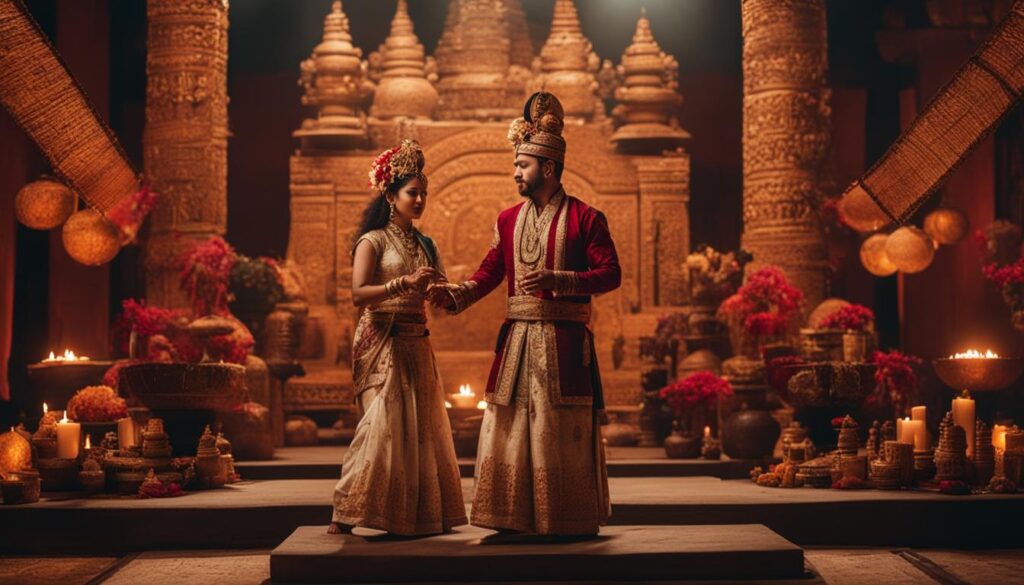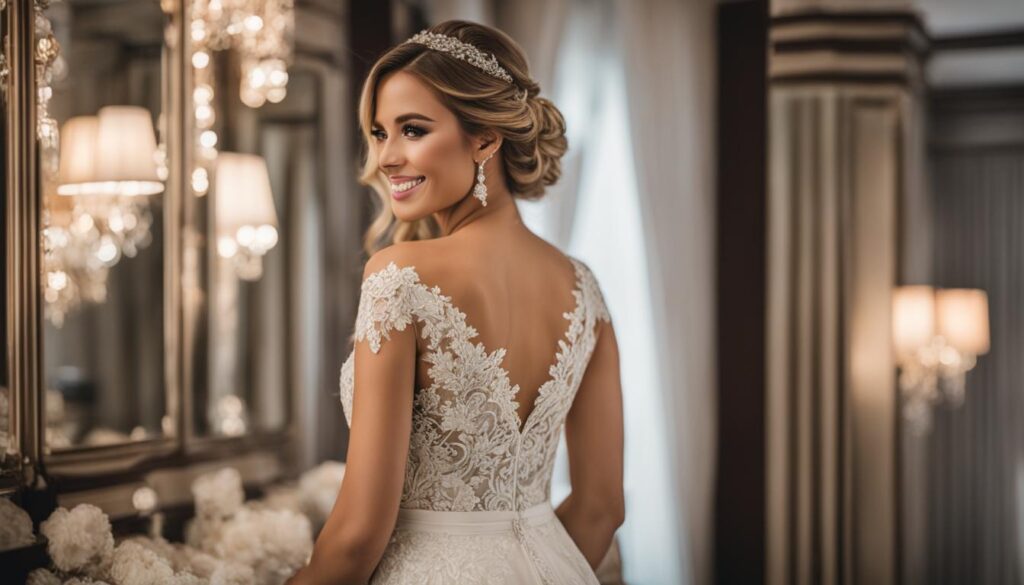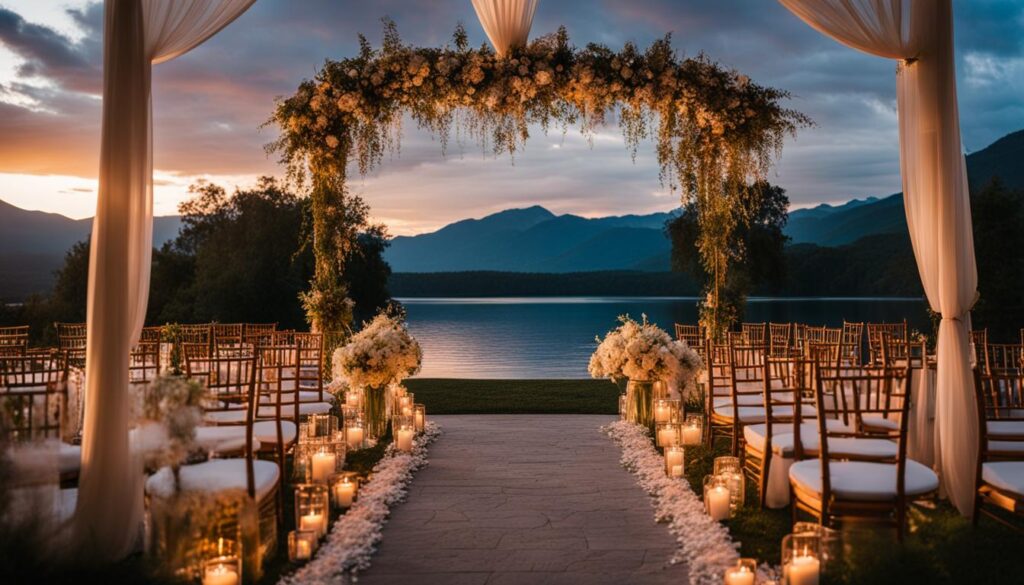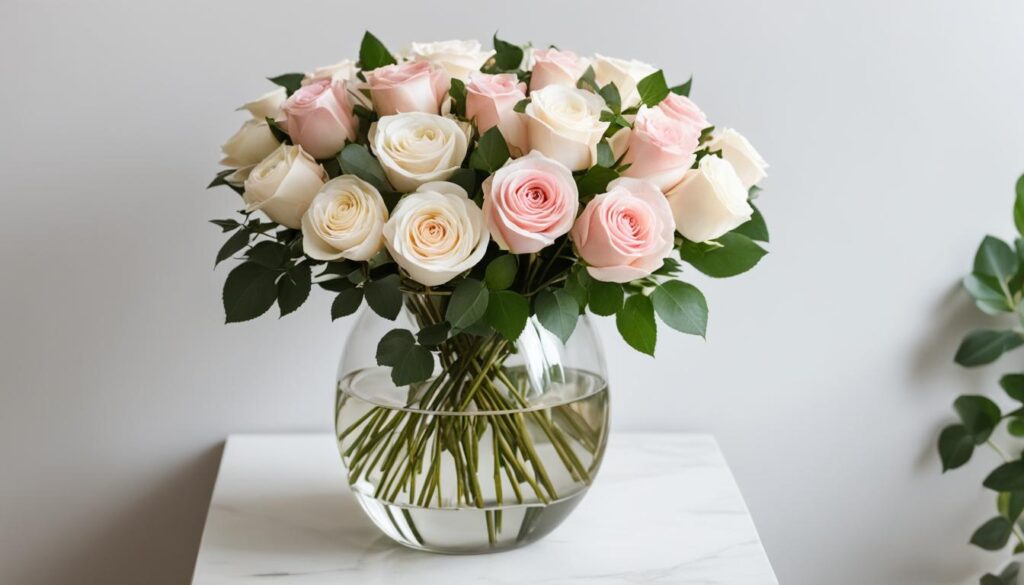We may earn money or products from the companies mentioned in this post.
Marriage is the ultimate declaration of love and commitment, and the customs and traditions surrounding it are as diverse as the people celebrating them. From ancient rituals to contemporary ceremonies, each tradition holds a unique significance that illuminates a culture’s history and values.
In this section, we will explore various global marriage ceremony traditions and how they have evolved over time. Join us on a journey through the rich tapestry of cultures that unite people in love and commitment.
Key Takeaways
- Marriage traditions vary widely across different cultures and regions.
- Symbolic wedding practices, such as exchanging rings and lighting unity candles, play an important role in many marriage ceremonies.
- Ancient wedding ceremonies have shaped modern marriage rites, and many couples incorporate traditional customs into their special day.
- Contemporary marriage rituals continue to evolve, reflecting the values and preferences of couples today.
- Marriage ceremony traditions celebrate the universal human experience of love and commitment, showcasing the beauty of cultural diversity.
Wedding Traditions Around the World
Weddings serve as a beautiful reminder of the diverse cultures and customs that exist around the world. From India to Japan, Africa to Australia, and everywhere in between, each culture has its unique way of celebrating the union of two people in love. In this section, we will explore different traditional marriage rituals, cultural wedding customs, and unique wedding traditions from all corners of the globe.
Indian Weddings
Indian weddings are steeped in tradition and can last up to five days. They involve a series of intricate ceremonies that include the Sangeet, Mehndi, Baraat, Kanyadaan, and many others. The groom and his family arrive at the bride’s house on horseback, and the bride is welcomed with a shower of flower petals. The exchanging of garlands, known as the Jaimala ceremony, symbolizes a couple’s acceptance of each other as partners for life.
Chinese Weddings
Chinese weddings adhere to an ancient tradition that dates back thousands of years. The bride’s family sends a dowry to the groom’s family, who then presents the bride’s family with a bridal gift. During the ceremony, the bride and groom perform the three bows of the three bows ceremony, which symbolizes the merging of two families. The bride wears a red dress, while the groom wears an embroidered robe. The color red is associated with good luck and fortune in Chinese culture
African Weddings
Weddings in Africa represent a beautiful amalgamation of tradition and modernity. These weddings are vibrant and colorful events that include the entire community. The ceremony is usually held in a public place or village square and begins with a procession that includes the couple and their families. The bride and groom typically wear bright, traditional attire that represents their cultural heritage.
Hawaiian Weddings
Hawaiian weddings are a perfect blend of simplicity and elegance. The ceremony takes place outdoors, with the couple exchanging vows under a beautiful arch decorated with flowers. The bride and groom wear leis, which are traditional Hawaiian garlands, and exchange flower necklaces during the ceremony. After the vows, everyone wears Hawaiian shirts and enjoys a feast of fresh seafood and roasted pork.
Mexican Weddings
When it comes to Mexican weddings, tradition is key. The couple typically holds two ceremonies—one in the civil court and one in the church. During the church ceremony, the couple performs the lazo ceremony, where a long rosary is draped around their necks in a figure-eight symbolizing their everlasting unity. Mexican weddings are also known for their lively and upbeat music, with the traditional mariachi band often performing at the celebration.
Symbolic Wedding Practices
Weddings are joyous occasions where two individuals join in love and commitment. Traditional wedding customs, such as symbolic wedding practices, have played a significant role in marriage ceremonies for centuries. These practices give meaning and depth to the exchange of vows and rings. In this section, we will uncover some of the most popular symbolic wedding practices and explore their significance.
Exchanging Rings
The exchange of wedding rings is perhaps the most widely recognized symbolic act in marriage ceremonies. The tradition dates back to ancient Egypt, where rings were considered a symbol of eternity. Rings represent unending love, with the circular shape symbolizing the eternal nature of marriage. The ring finger was chosen as the spot for the wedding ring because it was believed to hold a vein that runs directly to the heart.
Lighting Unity Candles
Another popular symbolic wedding practice is the lighting of unity candles. During the ceremony, the bride and groom each light a candle, then come together to light a third candle, known as the unity candle. This action symbolizes the merging of two individuals into a united couple, with the individual flames coming together to form a single, stronger flame.
| Symbolic Acts | Significance |
|---|---|
| Exchanging Rings | Symbolizes eternal love |
| Lighting Unity Candles | Represents two becoming one |
| Performing a Sand Ceremony | Symbolizes the blending of two lives |
Performing a Sand Ceremony
A sand ceremony involves the couple pouring different colored sand into a single container, representing the blending of two lives and families. It is an excellent option for outdoor weddings and creates a unique and lasting keepsake for the couple. The sand can be saved in a jar or decorative container as a reminder of the special day.
Symbolic wedding practices, such as exchanging rings, lighting unity candles, and performing a sand ceremony, hold great meaning and significance in traditional wedding customs. These acts serve to honor the joining of two individuals in marriage and create lasting memories that will be treasured for years to come.
Ancient Wedding Ceremonies
Ancient wedding ceremonies have been the cornerstone of modern marriage rites and have influenced traditional wedding ceremony ideas for centuries. From Egypt’s practiced belief in exchanging wedding rings to China’s symbolic tea ceremony, ancient cultures have developed rituals and customs that still remain relevant to this day. Uncovering these traditions and understanding their significance could provide a fresh perspective and may inspire you to incorporate them into your own wedding ceremony.
Here are some examples of ancient wedding ceremonies around the world:
| Culture | Wedding Ceremony |
|---|---|
| China | In ancient China, the tea ceremony is a vital part of the Wedding Ceremony. The newlyweds serve tea to their parents and in-laws, symbolizing their gratitude and respect. |
| India | The traditional Indian wedding ceremony starts with the mehndi or henna ceremony. The bride has intricate henna patterns painted on her hands and feet, while singing and dancing take place in celebration. |
| Japan | In Japan, sake is served to symbolize the formal union of the couple. The bride and groom take turns drinking from three cups of sake — one is offered to the gods, the second one is for the couple, and the third is given to the bride’s father as a sign of gratitude for raising her. |
| Africa | In an African wedding ceremony, dance and music play a significant role as they symbolize the unification of the two families. Communities sing, dance, and perform rituals together as they welcome the couple into their family. |
By incorporating elements of ancient wedding ceremonies, you can create a unique and meaningful traditional wedding ceremony that reflects your cultural heritage and celebrates the history of your love.
Modern Marriage Rituals
As we evolve, so do our marriage rituals. The desire to personalize the wedding ceremony has given rise to modern marriage rituals that showcase the unique values and personalities of the couple. From writing personal vows to creating custom unity ceremonies, couples are finding new ways to incorporate tradition into their modern weddings.
The Rise of Cultural Fusions
Incorporating cultural traditions into modern weddings allows couples to reflect their heritage and embrace different cultures. Customs such as the Indian Saptapadi, which involves taking seven vows around a sacred fire, or the Filipino tradition of tying a cord or veil to symbolize unity, are gaining popularity. These meaningful customs are a way to honor one’s heritage while creating new traditions.
Technology and Marriage
Technology has made it easier to plan and personalize wedding ceremonies. Social media platforms like Pinterest and Instagram offer endless inspiration for non-traditional wedding ideas. Couples can create custom hashtags to capture every moment of their big day or even incorporate virtual reality into the ceremony for a truly one-of-a-kind experience.
Green Weddings
As couples become more environmentally conscious, eco-friendly weddings have become increasingly popular. From wedding favors made of sustainable materials to locally sourced and organic food, couples are finding ways to make the wedding eco-friendly. Weddings can also be an opportunity to give back to the community by donating to environmental causes or finding creative ways to repurpose wedding decor.
| Modern Marriage Rituals | Traditional Wedding Ideas |
|---|---|
| Personalized vows | Reciting standard traditional vows |
| Green weddings | Traditional floral arrangements |
| Vintage-inspired themes | Ballroom-style receptions |
| Non-traditional wedding venues | Churches or synagogues |
Modern marriage rituals show that tradition and innovation can coexist in beautiful harmony. Whether it’s incorporating cultural traditions or embracing eco-friendly practices, modern weddings are a way to celebrate love in a way that reflects the values and personalities of the couple.
Conclusion
Marriage ceremony traditions have the power to connect people from different corners of the world. It is fascinating to see the diversity of cultural wedding customs and traditional marriage rituals that have been passed down through generations. Symbolic wedding practices play an essential role in many marriage ceremonies, and it is heartening to learn about the deeper meanings behind these traditional wedding customs.
While ancient wedding ceremonies shaped the foundation of modern marriage rites, contemporary wedding customs and practices reflect the values and preferences of couples today. Whether honoring ancient rituals or embracing modern customs, these traditions create meaningful memories that last a lifetime.
As you plan your wedding, find inspiration in the rich tapestry of global marriage ceremony traditions. Incorporate the rituals and customs that resonate with you and your partner, creating a unique ceremony that celebrates your love and commitment.
Affiliate Disclosure: This post may contain affiliate links. If you purchase through our link, we may receive a small commission, but at no additional cost to you. For more information, please see our Disclosure statement.



